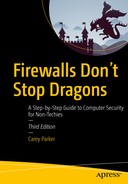Glossary
application . Pieces of software that you launch on your computer to help you do something. Examples include Microsoft Word, Internet Explorer, Firefox, iTunes, Photos, and Outlook.
bandwidth . Used to describe how fast data can travel over a given connection. You most often see this when your Internet service provider tells you how fast you can download something from the Internet.
bit . The smallest piece of computer data. This can be either a zero or a one, making it binary.
Bluetooth . A short-range, low-power wireless technology mostly used to remove the need for wires. Commonly used with wireless headsets, computer mice, keyboards, and sometimes remote controls.
byte . A chunk of computer data equal to eight bits. When talking about many bytes, we use metric prefixes like kilo- (thousand), mega- (million), giga- (billion) and tera- (trillion).
cloud, the . Refers in a general, vague way to all the services and servers out on the Internet. When you store data “in the cloud,” it’s stored on some big computer on the Internet that’s run and owned by a company or service provider.
Ethernet . The technical name of the standard used to connect computers to a network using wires. Ethernet cables look like home phone cables, but the rectangular clip connector at the end is wider.
file manager . The name for the operating system tool that lets you view, move, copy, rename, or delete files. On Windows, this is called the Windows Explorer or File Explorer; on Mac, it’s called the Finder.
hardware . The parts of a computer that you can see and touch: the computer, monitor, keyboard, mouse, printer, webcam, and so on.
ISP. Internet service provider. This is the company that gets you connected to the Internet. Examples are Comcast, Spectrum, Verizon FiOS, and Google Fiber. When you connect to the Internet with your smartphone, your ISP is your cellular provider.
LAN. Local area network. Your home network is a LAN, as is the network at the office where you work. LANs are smaller, private networks (as opposed to the Internet).
malvertising . Web advertising that contains links to malicious websites or actual malicious software that runs in the ad itself.
malware . Software that is built to do “bad” things, ranging from giving you annoying advertisements to actually corrupting or controlling your computer. Examples include viruses, spyware, and trojan horses.
modem . A small box that converts your Internet service provider’s special type of connection (cable, phone line, fiber optic, or satellite) to a standard network connection (Ethernet). You usually rent this box from your ISP. Sometimes these modems will also include a built-in Wi-Fi router.
net neutrality . A concept that says everyone should have equal and fair access to everyone else on the Internet—companies with more money shouldn’t be able to get privileged access.
network . Two or more computers or devices that are connected and communicate using a common language, or protocol. Networks today use Internet Protocol (IP).
operating system . A special piece of software that runs the entire computer. Examples include Microsoft Windows and Mac OS X.
ransomware . A particular type of malware that surreptitiously encrypts all of your computer’s files and then demands payment to decrypt them.
router . The box on your network that separates your local area network (LAN) from the Internet. In most homes today, the router is a Wi-Fi router.
server . Fancy name for a big computer out on the network whose job it is to do something for you. It might hold your e-mail or let you buy something online or stream you a movie. Your computer (the one requesting something) is the client.
software . The general term for any program that runs on your computer, including applications and the operating system.
spam . Unwanted or junk e-mail.
WAN. Wide area network. This usually refers to the Internet, but it may also refer to a large corporate network that spans many sites.
Wi-Fi . The wireless communication standard used by computers and smart devices to connect to the network. This is also referred to by the technical name 802.11.
WLAN. Wireless LAN. This is the type of network created by a Wi-Fi router.
